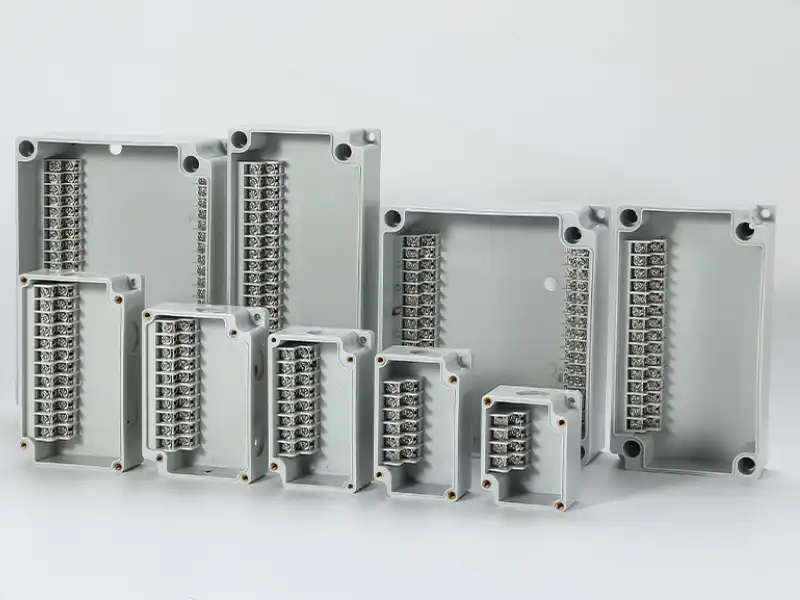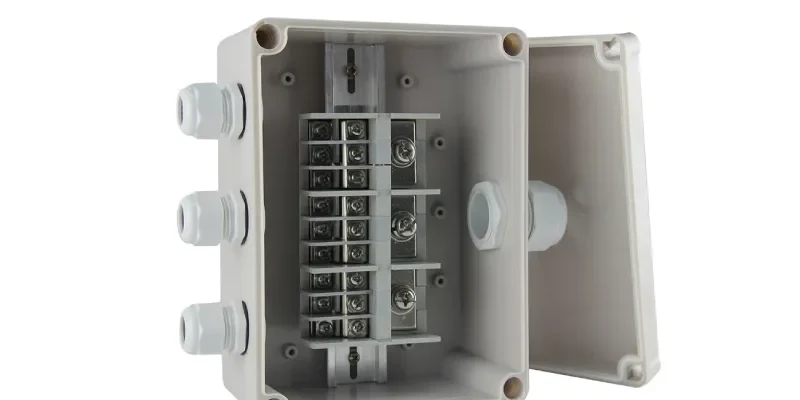Koblingsbokser med klemmer er viktige elektriske kapslinger som er utformet for å koble til og beskytte ledningstilkoblinger på en sikker måte, med ulike konfigurasjoner av klemmer, beskyttelsesgrader og materialalternativer for å passe til ulike bruksområder og installasjonskrav.

Forklaring av terminalkonfigurasjoner
Klemmekonfigurasjoner i koblingsbokser spiller en avgjørende rolle når det gjelder tilkobling og fordeling av elektriske kretser. Vanligvis har disse boksene 3-6 klemmer, noe som gjør det mulig å koble sammen flere kabelkjerner. Antall klemmer har direkte innvirkning på boksens allsidighet, ettersom flere klemmer gjør det mulig å koble sammen et større antall kabler i ett og samme kabinett. Hovedklemmeblokkene er utformet for å kunne romme ulike kabeltverrsnitt, for eksempel 2 x 25 mm² + 2 x 16 mm² per pol, noe som gir fleksibilitet for ulike ledningsbehov. Denne tilpasningsdyktigheten gjør det mulig for elektrikere å håndtere komplekse kablingssystemer på en effektiv måte, samtidig som installasjonen blir kompakt og oversiktlig.
Materiale og beskyttelsesfunksjoner
Koblingsbokser med klemmer er utviklet for å gi robust beskyttelse for elektriske tilkoblinger i ulike miljøer. Koblingsbokser i plast, for eksempel av PVC eller polykarbonat, er svært motstandsdyktige mot korrosjon og kjemikalier, noe som gjør dem egnet for både innendørs og utendørs bruk. Disse boksene leveres ofte med høy kapslingsgrad, for eksempel IP67, som sikrer fullstendig beskyttelse mot støv og midlertidig nedsenking i vann.
Mange koblingsbokser har utstikkbare innganger og værbestandig design for bedre holdbarhet og værbestandighet. Dette gir sikker kabelinnføring samtidig som boksens beskyttende egenskaper opprettholdes. Valg av materiale og beskyttelsesfunksjoner avhenger av de spesifikke installasjonskravene, med alternativer som spenner fra standard innendørsbokser til kraftige utendørskabinetter som tåler tøffe miljøforhold.
Materialer til koblingsboksen
Koblingsbokser med terminaler er vanligvis laget av tre hovedmaterialer: plast, metall og glassfiber, som alle har unike egenskaper som egner seg til ulike bruksområder.
- Plast: Vanlige materialer er PVC, polykarbonat og ABS. Disse boksene er lette, kostnadseffektive og motstandsdyktige mot korrosjon. De isolerer godt og er ikke-ledende, noe som gjør dem egnet for mange elektriske bruksområder. Plastbokser kan imidlertid være mindre holdbare og mer utsatt for skader som følge av støt eller ekstreme temperaturer.
- Metall: Stål, aluminium og rustfritt stål er vanlige valg for koblingsbokser i metall. Disse gir overlegen holdbarhet, brannmotstand og beskyttelse i tøffe miljøer. Metallbokser gir også mulighet for jording, noe som kan være avgjørende for elsikkerheten. De er imidlertid generelt tyngre og dyrere enn alternativer i plast.
- Glassfiber: Koblingsbokser i glassfiber er en balanse mellom plast og metall. De er lette, sterke og svært motstandsdyktige mot korrosjon, fuktighet og kjemikalier. Glassfiberbokser er ikke-ledende og har høy dielektrisk styrke, noe som gjør dem egnet for miljøer der det kreves både holdbarhet og elektrisk isolasjon.
Strømverdier og bruksområder
Koblingsbokser er tilgjengelige i ulike strømstyrker for å passe til ulike elektriske bruksområder. Blant de vanligste strømtallene er 24 A for enkle belysningskretser, 32 A for alminnelig bruk og 40 A for høyeffektsapplikasjoner som dusjer og komfyrer. Valg av riktig strømstyrke er avgjørende for å sikre trygge og effektive elektriske installasjoner. Ved høyere strømstyrker, som 40 A, er det avgjørende at installasjonen utføres av en kvalifisert elektriker på grunn av de kompliserte tilkoblingene og den potensielle sikkerhetsrisikoen som er involvert.
Installasjon og profesjonell veiledning
Ved installasjon av koblingsbokser er det avgjørende å velge klemmer med omhu. Antall klemmer som kreves, avhenger av de spesifikke kretstilkoblingene, type elektrisk installasjon og antall kabler som skal kobles sammen. Ved komplekse installasjoner eller høyere strømstyrker, for eksempel 40A-kretser, er det avgjørende at installasjonen utføres av en kvalifisert elektriker for å ivareta sikkerheten og samsvar med elektriske forskrifter. Riktig installasjon garanterer ikke bare integriteten til de elektriske tilkoblingene, men maksimerer også koblingsboksens beskyttende egenskaper, slik som værbestandighet og slagfasthet.
Relatert artikkel
Forståelse av koblingsbokser: Viktige komponenter for sikre og effektive elektriske systemer


